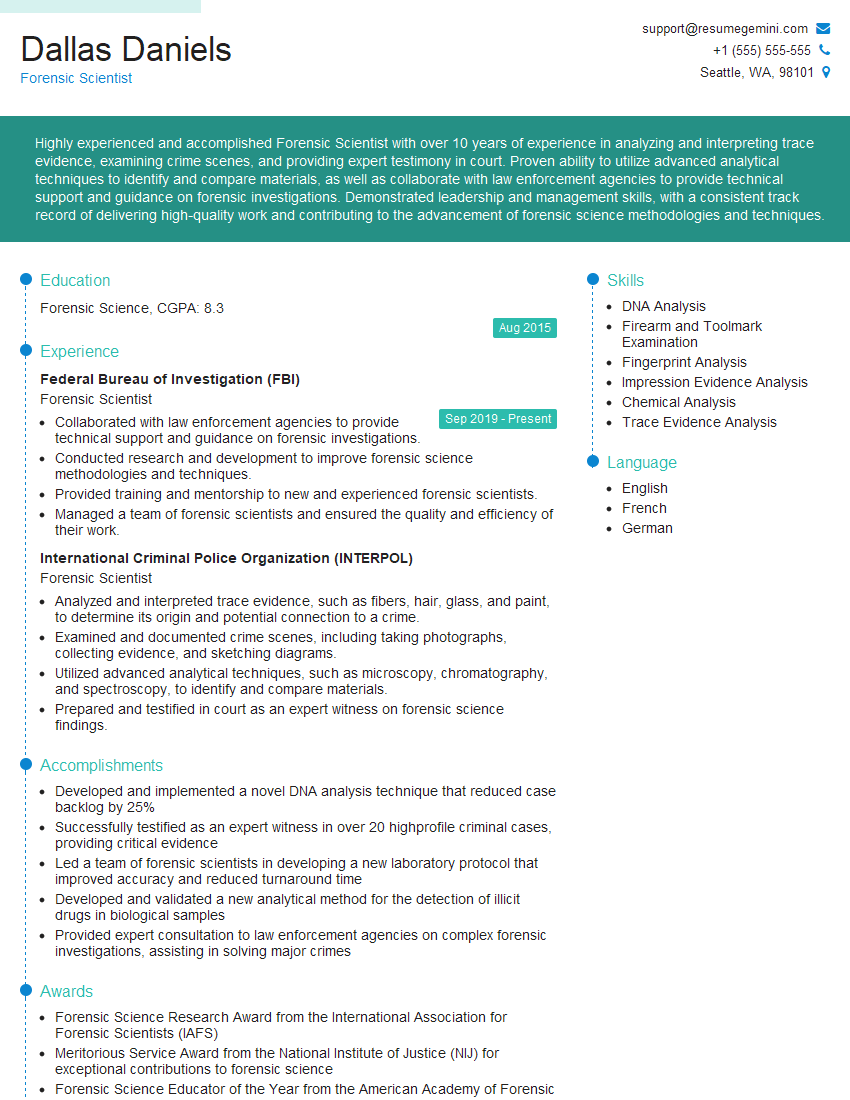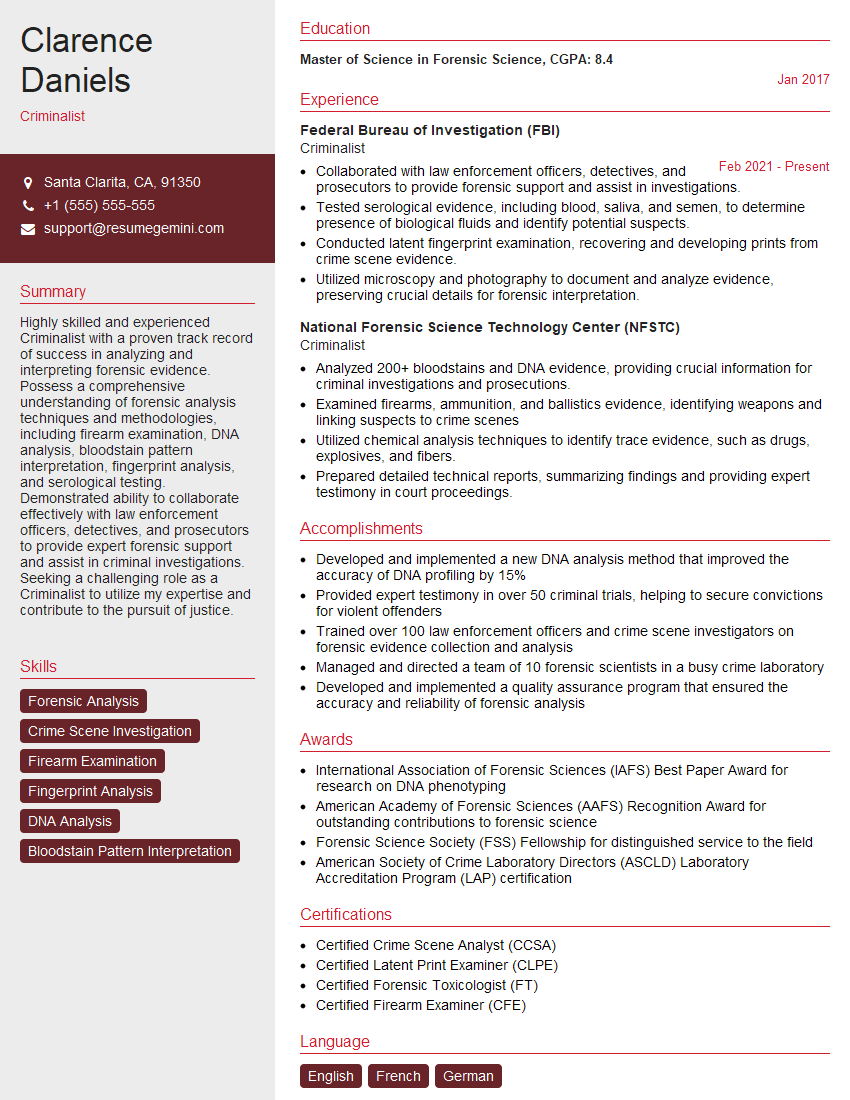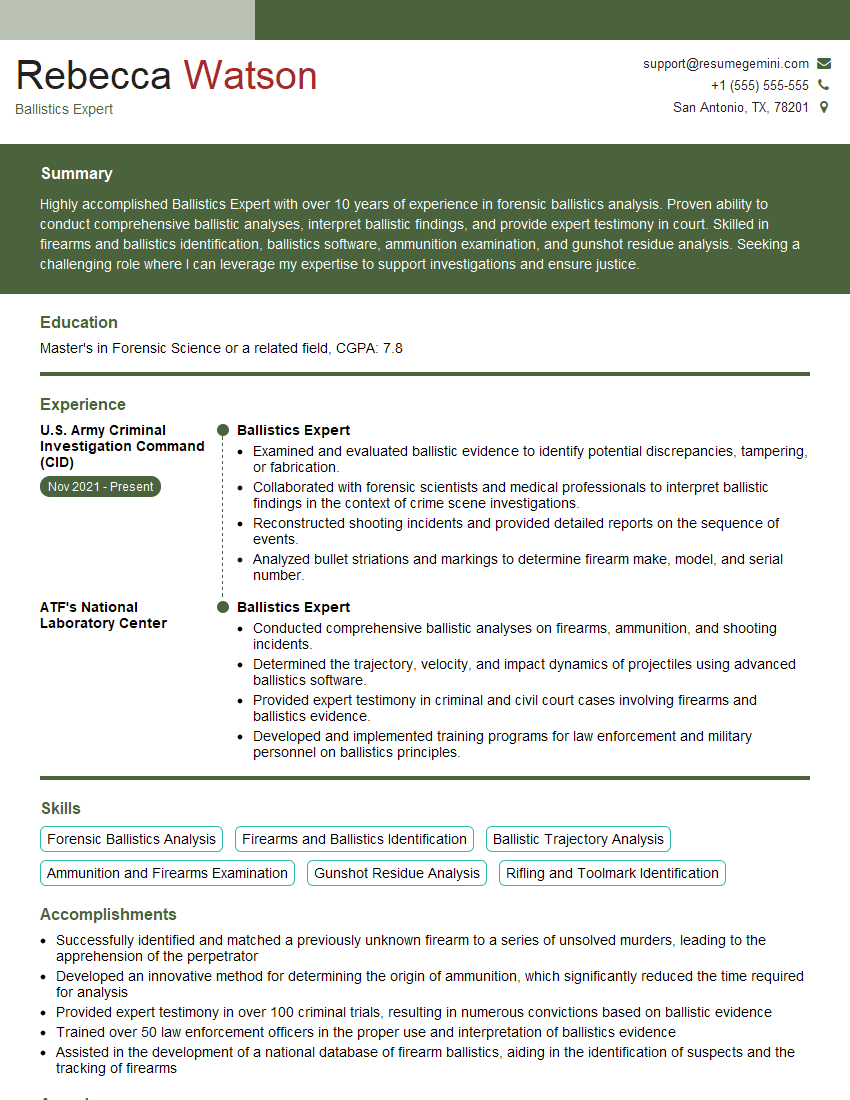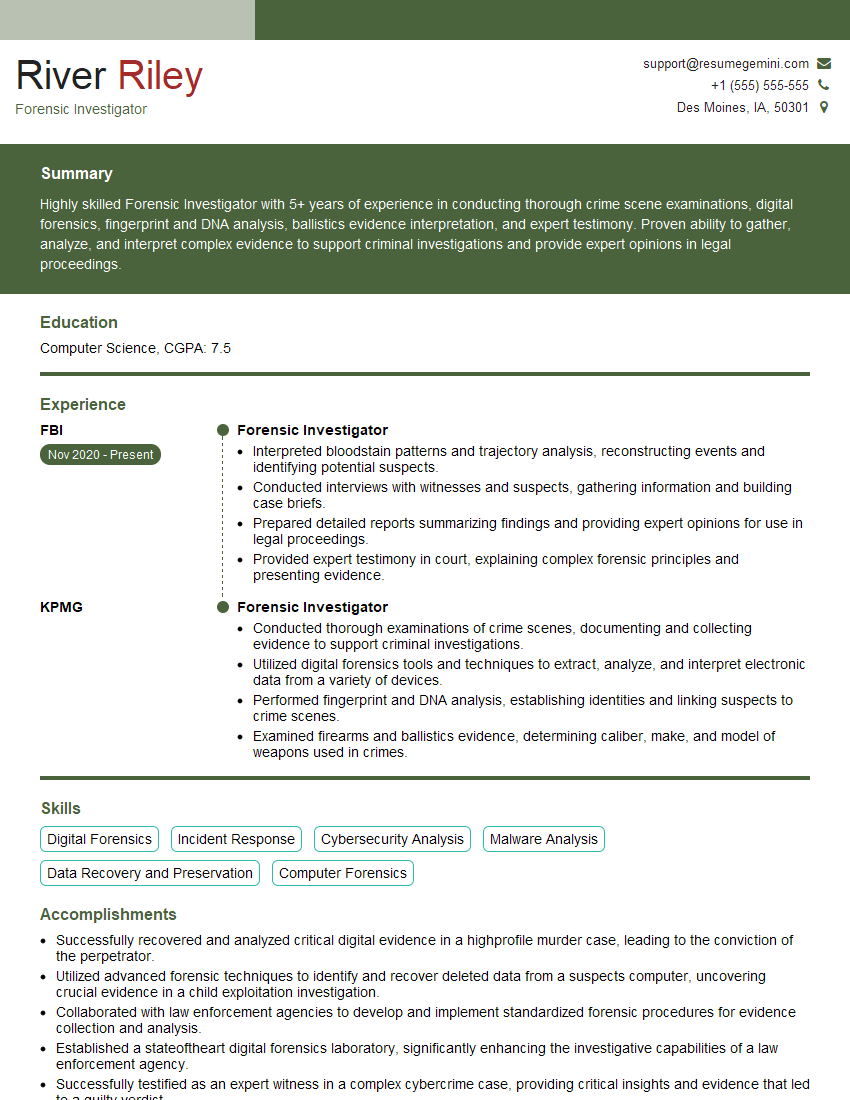Are you ready to stand out in your next interview? Understanding and preparing for Bullet Comparison interview questions is a game-changer. In this blog, we’ve compiled key questions and expert advice to help you showcase your skills with confidence and precision. Let’s get started on your journey to acing the interview.
Questions Asked in Bullet Comparison Interview
Q 1. Describe the process of bullet comparison using a comparison microscope.
Bullet comparison using a comparison microscope is a crucial forensic technique for linking fired bullets to a specific firearm. The process involves simultaneously viewing two bullets – a test bullet fired from a suspected weapon and a recovered bullet from a crime scene – under a comparison microscope. This microscope has two independent optical paths, allowing the examiner to see both bullets side-by-side in a single field of view. The examiner then systematically compares the microscopic markings on the bullets, looking for similarities.
The process typically begins with a macro-level examination, observing the overall shape and size of the bullets. Then, the examiner carefully scrutinizes the microscopic markings, primarily focusing on the striations left by the rifling inside the gun barrel. These striations are unique to each barrel and act like a fingerprint. By carefully aligning the bullets and comparing these markings, the examiner can determine if there’s a match. If the striations on both bullets show a significant number of corresponding markings consistent with each other, a positive association is made. The examiner must also consider other features, like the presence or absence of tool marks.
Imagine looking at two identical-looking snowflakes under magnification. While initially appearing alike, upon closer examination, subtle differences in their patterns become apparent. Similarly, bullets often display minute markings that become essential in determining whether they originated from the same firearm.
Q 2. Explain the difference between class and individual characteristics in bullet analysis.
In bullet analysis, class characteristics and individual characteristics are two distinct types of markings on a bullet that provide different levels of information.
Class characteristics are features that are common to all bullets fired from a particular firearm model. They result from the manufacturing process of the firearm. For example, the caliber of the bullet (its diameter), the number of lands and grooves in the rifling, and their twist direction are class characteristics. They narrow down the possibilities but don’t uniquely identify a specific weapon. Imagine all cars of a specific make and model; they share common characteristics, such as the engine type and the body shape.
Individual characteristics are unique markings on a bullet caused by imperfections and wear in the firearm’s barrel. These markings are random and unique to that specific barrel. They are the result of the manufacturing process as well as use, scratches, erosion, and other imperfections and are considered to be the ‘fingerprint’ of the weapon. These are created when the bullet passes through the gun barrel and are much more specific and reliable for identification. This is analogous to comparing fingerprints—even identical twins have distinct fingerprints.
To illustrate, if two bullets share the same caliber and rifling pattern (class characteristics), but also exhibit matching microscopic striations (individual characteristics), a strong association can be made, linking them to the same weapon.
Q 3. What are the limitations of bullet comparison?
Bullet comparison, while a powerful technique, does have limitations. These include:
Bullet damage: Significant damage to a bullet can obscure or destroy crucial individual characteristics, making comparison difficult or impossible. A bullet heavily deformed by impact might not provide sufficient markings for a conclusive comparison.
Insufficient markings: Some firearms may leave poorly defined or insufficient markings on bullets, hindering a definitive comparison. This can happen with poorly maintained weapons or those with newly manufactured barrels that haven’t yet developed distinctive wear patterns.
Lead bullets: Lead bullets are particularly soft and may exhibit significant deformation, even from a short distance, making detailed comparison difficult.
Subjectivity: While the process is highly systematic, there is a degree of subjectivity involved in evaluating the significance of markings. Experienced examiners are crucial to minimize bias and ensure reliable interpretation.
Lack of reference bullets: If test bullets aren’t available from the suspected weapon, comparison becomes impossible.
These limitations highlight the need for careful handling of evidence and thorough documentation of all aspects of the comparison process.
Q 4. How do you document bullet comparison findings?
Documentation of bullet comparison findings is critical for maintaining the integrity and admissibility of the evidence in court. A comprehensive report should include detailed notes, photography, and sketches. The process involves several steps:
Detailed descriptions: The report starts with descriptions of the bullets, noting their caliber, weight, type of metal, and any visible damage.
Microscopic comparison notes: A detailed account of the microscopic comparison should be documented, including the specific markings observed on both bullets, their locations, and similarities. Sketching these features is also beneficial.
Photography: High-quality photomicrographs of both bullets and their corresponding markings are essential. These should be carefully labeled and included in the report to provide visual evidence of the comparison.
Comparison microscope settings: The settings of the comparison microscope (magnification, lighting, etc.) used should be recorded to ensure reproducibility.
Conclusion: The report concludes with a statement of the examiner’s findings – whether a positive association was established, a negative association was determined, or an inconclusive result was obtained. The basis for this conclusion must be clearly articulated.
The entire process is meticulously documented to ensure transparency, accuracy, and the ability to withstand scrutiny in a court of law.
Q 5. Describe the role of microscopy in bullet comparison.
Microscopy plays a pivotal role in bullet comparison, as it allows examiners to visualize and compare microscopic markings on bullets that are otherwise invisible to the naked eye. The comparison microscope is the primary tool used, providing simultaneous viewing of two bullets under high magnification. This instrument enables the side-by-side comparison of striations and other microscopic imperfections that provide unique identification potential.
Different types of microscopy techniques may be employed depending on the requirements and complexity of the case, but the comparison microscope remains the cornerstone of the analysis. The magnification capabilities enable precise comparison of individual characteristics, enhancing the reliability of the findings and allowing for highly detailed analysis of the bullet surfaces.
Q 6. What are some common types of bullet damage and their implications?
Bullets can suffer various types of damage during their trajectory and impact, which can affect their suitability for comparison. Some common types of bullet damage and their implications include:
Deformation: Significant deformation of the bullet, such as flattening or fragmentation, can obscure critical markings needed for comparison. Highly deformed bullets may yield inconclusive results.
Fragmentation: If the bullet breaks into fragments upon impact, the reconstruction of the original bullet may be very difficult, leading to a loss of crucial evidence.
Erosion and melting: High-velocity impacts can cause erosion and melting of the bullet’s surface, potentially removing individual characteristics.
Obscured markings: Dirt, debris, or other contaminants that adhere to the bullet’s surface can obscure markings, thus making comparison challenging or impossible.
Ricochet: When a bullet ricochets, it undergoes considerable deformation and marking changes, which can complicate comparison.
The extent of damage influences the reliability of the comparison. Severely damaged bullets can lead to inconclusive results, and only fragments may remain available for examination. Proper handling and preservation of bullets are critical to minimize the risk of further damage.
Q 7. Explain the concept of striations and their significance in bullet identification.
Striations are microscopic scratches or lines found on the surface of a bullet. They are formed when the bullet travels through the rifled barrel of a firearm. The rifling, which consists of spiral grooves and lands (raised areas between the grooves), imparts unique striations to each bullet fired from a particular firearm. These striations are considered individual characteristics, as their patterns are unique to each gun barrel. They are created by the interaction between the bullet and the microscopic imperfections in the barrel’s surface.
The significance of striations in bullet identification stems from their uniqueness. Just as fingerprints are used to identify individuals, the unique pattern of striations on a bullet can help to link a bullet to a specific firearm. By comparing the striations on a recovered bullet from a crime scene to those of a test bullet fired from a suspected firearm, forensic examiners can potentially establish a match, providing strong evidence in criminal investigations.
Think of it like a custom-made mold. Every time you cast something using that mold, it will have its unique imprints. Similarly, each firearm, despite being of the same make and model, will have unique microscopic irregularities in its barrel that create the distinct pattern of striations on each bullet fired.
Q 8. How do you handle and preserve bullets for comparison analysis?
Handling and preserving bullets for comparison is crucial for maintaining their evidentiary value. Improper handling can lead to contamination or damage, rendering them useless in court. The process begins at the crime scene. Bullets are carefully collected using forceps or other appropriate tools, avoiding direct contact with bare hands. Each bullet is individually bagged and labeled with essential information like the case number, date, time of collection, location, and the collector’s initials. The evidence bags are then sealed and marked with tamper-evident tape. They are stored in a secure, climate-controlled environment to prevent degradation or alteration. This prevents the introduction of foreign material and ensures the integrity of the evidence throughout the investigative process. For instance, if a bullet is found embedded in a wall, the entire section of wall containing the bullet might be carefully removed to preserve its context. This whole section becomes part of the evidence.
Q 9. Describe the chain of custody procedures for bullet evidence.
Chain of custody meticulously documents every individual who handles the bullet evidence from the crime scene to the courtroom. This rigorous process ensures the evidence’s integrity and admissibility in court. It involves a detailed log that records each transfer of the evidence, including the date, time, recipient, and the reason for transfer. Each person handling the evidence signs the log, acknowledging their responsibility. Any deviations or discrepancies in the chain of custody can significantly weaken the evidentiary value of the bullets and may lead to their inadmissibility. Think of it like a relay race; each runner (person handling the evidence) must carefully pass the baton (the evidence) to the next runner, documenting each transfer. A broken chain can mean the race (the case) is disqualified.
Q 10. What are some common sources of error in bullet comparison?
Several factors can introduce errors in bullet comparison. Damage to the bullet during firing or recovery can obscure crucial markings. For example, a bullet that ricochets off a hard surface might become significantly deformed, making comparison difficult. Another significant source of error is the handling and storage of the evidence; improper handling, as discussed earlier, can damage the bullet or introduce contamination. Also, the limitations of the comparison microscope itself can introduce inconsistencies. The examiner’s experience and interpretation also play a role. Subjectivity in assessment, even with experienced examiners, can be a source of variation. Finally, the quality of test-fired bullets used for comparison is crucial. Inconsistencies in the test-firing process could lead to inaccurate comparisons. Imagine trying to compare fingerprints that are smudged or incomplete; similar limitations affect the accuracy of bullet comparisons. Careful attention to detail throughout the process is vital.
Q 11. How do you differentiate between bullets fired from different firearms?
Differentiating bullets fired from different firearms relies on the unique microscopic markings left on the bullets during the firing process. Each firearm’s barrel has unique characteristics due to manufacturing imperfections and wear during use. These imperfections leave distinct striations (scratches) on the bullet’s surface as it travels through the barrel. The comparison microscope allows a side-by-side comparison of the test-fired bullet (fired from a suspected firearm) and the recovered bullet from the crime scene. Matching striation patterns strongly suggest that both bullets were fired from the same weapon. However, a lack of complete matching doesn’t necessarily mean they came from different guns; damage or partial impressions can make definitive conclusions difficult. The process involves a detailed, systematic comparison of the lands and grooves, as well as the individual striations within them, looking for consistent and unique characteristics. It’s like comparing two highly detailed puzzle pieces. A complete match indicates a high probability of a common origin.
Q 12. Explain the significance of land and groove impressions in bullet identification.
Lands and grooves are the raised and recessed portions of a firearm’s barrel. As a bullet passes through the barrel, the lands leave impressions on the bullet’s surface, creating striations. The number of lands and grooves, their width, and the direction of twist are characteristics used to classify firearms. This information helps narrow down the possibilities. However, the unique microscopic striations on the bullet’s surface, caused by imperfections in the barrel, are critical for individualizing the bullet to a specific weapon. The comparison of these minute characteristics is the cornerstone of bullet identification. Think of it as a unique fingerprint for the weapon. While the overall pattern of lands and grooves might be common to a type of firearm, the individual striations are unique to the specific barrel.
Q 13. What is the role of image analysis software in bullet comparison?
Image analysis software plays a significant role in modern bullet comparison. It enhances the visualization of microscopic markings, allowing for more detailed and objective comparisons. The software can digitally enhance images, measuring distances between striations, quantifying their depth, and creating overlays to facilitate side-by-side comparison. It provides tools for objective measurement and documentation that reduces the reliance on subjective interpretation. This is especially valuable when dealing with damaged or fragmented bullets where visual assessment can be challenging. The software also helps create comprehensive reports including high-resolution images and quantitative data that are crucial for presenting evidence in court. In essence, it acts as a powerful tool assisting the examiner in making accurate and well-supported conclusions.
Q 14. How do you interpret and present your findings in a court of law?
Presenting findings in court requires clarity, objectivity, and a strong understanding of the legal process. The examiner’s testimony should focus on the objective scientific findings, avoiding subjective opinions or speculation. The presentation involves clear explanations of the comparison methodology, the software used (if any), and a detailed description of the similarities and differences found between the bullets. Any limitations or uncertainties in the analysis are openly addressed. The examiner presents the findings as probabilities or degrees of certainty rather than absolute statements. For example, rather than saying ‘These bullets definitely came from the same gun,’ a more appropriate statement might be ‘Based on my analysis, there is a high degree of probability that these bullets were fired from the same firearm.’ The use of visual aids like magnified images and comparison charts enhances the clarity of the presentation. The overall aim is to provide the court with the scientific evidence objectively and transparently, allowing the jury to make their own informed decision.
Q 15. What are the ethical considerations in firearms examination?
Ethical considerations in firearms examination are paramount, ensuring objectivity, integrity, and adherence to legal standards. We must maintain impartiality, avoiding bias that could influence our conclusions. This means meticulously documenting every step of the process, acknowledging any limitations in our analysis, and presenting our findings honestly, even if they don’t support the initial hypothesis. For example, if a bullet shows signs of damage inconsistent with a specific firearm, we must report that honestly, rather than attempting to force a match. Confidentiality is another key aspect – the information we handle is often sensitive, and we must adhere to strict protocols regarding data security and disclosure. Finally, proper chain of custody is crucial; ensuring the integrity and traceability of evidence from collection to analysis is critical to the validity of our findings in court.
Career Expert Tips:
- Ace those interviews! Prepare effectively by reviewing the Top 50 Most Common Interview Questions on ResumeGemini.
- Navigate your job search with confidence! Explore a wide range of Career Tips on ResumeGemini. Learn about common challenges and recommendations to overcome them.
- Craft the perfect resume! Master the Art of Resume Writing with ResumeGemini’s guide. Showcase your unique qualifications and achievements effectively.
- Don’t miss out on holiday savings! Build your dream resume with ResumeGemini’s ATS optimized templates.
Q 16. Explain the use of databases in firearm identification.
National Ballistic Information Network (NIBIN) is a powerful tool in firearm identification. It’s a database containing digital images of spent cartridge casings and bullets recovered from crime scenes. When a firearm is discharged, its unique markings are imprinted on both the bullet and the casing. We capture high-resolution images of these markings using a comparison microscope. These images are then uploaded to NIBIN, where they’re compared against other entries in the database. A potential match generates a lead, indicating a possible link between a crime scene and a specific firearm. It’s important to note that NIBIN doesn’t provide definitive identification; it generates investigative leads. Confirmation requires further analysis and comparison, ideally, with a suspect firearm. Imagine it like a massive library of fingerprints – a quick way to narrow down possibilities, but requiring further individual verification.
Q 17. How do you deal with fragmented or damaged bullets?
Dealing with fragmented or damaged bullets presents challenges, but we employ several techniques to maximize the information we can obtain. Even small fragments can contain crucial striation marks, crucial for identification. We use various microscopy techniques, including low-power stereo microscopes and high-power comparison microscopes, to examine the fragments carefully. Advanced imaging techniques, like digital image enhancement, can be employed to clarify obscured features. Careful reconstruction of fragments is sometimes possible to reveal a more complete impression of the bullet’s markings. The process is akin to piecing together a jigsaw puzzle— patience and meticulous attention to detail are crucial. If the damage is extensive, we may still be able to exclude certain firearms, even if a positive identification is not possible. This negative identification is still valuable evidence.
Q 18. What is the importance of proper documentation and photography in bullet comparison?
Proper documentation and photography are indispensable for bullet comparison and the admissibility of evidence in court. Every step, from evidence collection to analysis, must be meticulously documented. This includes detailed descriptions of the evidence, chain of custody, and the procedures followed. High-quality photography is crucial for capturing the details of the bullet’s markings; this documentation serves as an objective record of the evidence’s condition and prevents misinterpretations or disputes later. We use standardized photographic techniques and utilize macro photography to capture the microscopic markings on the bullet’s surface. Think of this documentation as the forensic equivalent of a meticulous artist’s sketch—every detail must be accurately preserved to support our conclusions. Without proper documentation, our findings would lack credibility and legal standing.
Q 19. Explain the difference between rifling and bore.
The bore is the interior of a gun barrel, while rifling refers to the spiral grooves cut into the bore. Rifling is what imparts spin to the bullet, improving accuracy and stability. The bore’s diameter determines the caliber of the firearm. The rifling consists of lands (the raised portions) and grooves (the cut-out portions). The number of grooves, their width, and the twist rate (how quickly the rifling spirals) are characteristic features that leave unique markings on the bullet. Imagine the bore as a straw and the rifling as a spiral staircase inside the straw. The bullet travels through this staircase, picking up the unique markings as it spins.
Q 20. Describe the various types of comparison microscopes used in bullet analysis.
Comparison microscopes are specialized instruments used to simultaneously view two bullets side-by-side. The most common type is the two-barrel comparison microscope. This microscope allows a forensic examiner to simultaneously observe the striations on two bullets and compare them directly, offering a detailed side-by-side comparison. Modern comparison microscopes often incorporate digital imaging capabilities which enable easier documentation and analysis. Some advanced systems even allow for the comparison of three dimensional surfaces. This technology allows for enhanced analysis of highly complex markings. Different manufacturers produce various models with slight variations, but the core function remains the same: enabling a highly detailed side-by-side comparison for bullet identification.
Q 21. What are the challenges in comparing bullets from different calibers?
Comparing bullets of different calibers is generally not possible due to the inherent differences in bore diameter and rifling characteristics. The diameter itself precludes any meaningful comparison of striation markings. Moreover, different calibers generally use different rifling configurations, making any attempt at comparison futile. It’s like trying to compare apples and oranges – the fundamental differences in size and structure preclude any meaningful comparison. However, if there is a very unusual defect or marking on the projectile, shared between two very different calibers, that could offer a possible link, though this is extraordinarily rare. A positive identification would require similar rifling characteristics and a match in striations; this is not possible between different calibers.
Q 22. How do you deal with cases involving multiple firearms?
Dealing with multiple firearms in a case requires a systematic and meticulous approach. The key is to meticulously compare each bullet to each firearm, eliminating possibilities and focusing on consistent, unique markings. I start by carefully documenting each firearm and its unique characteristics, including manufacturer, model, and any visible damage. Then, I perform test-fires from each firearm, ensuring consistent ammunition is used. This generates a library of comparison samples. Next, I systematically compare each questioned bullet to each set of test-fired bullets from all the firearms. This comparison involves analyzing both class characteristics (e.g., caliber) and individual characteristics (unique striation marks). I use a comparison microscope, carefully aligning the bullets to maximize visualization of markings. The process eliminates possibilities methodically. If a definitive match is found, it’s reported. If not, the possibility of more firearms or other factors, such as bullet damage after firing, are considered. Statistical analysis may help evaluate the strength of any potential matches. For example, if only one firearm exhibits consistent striation matching with the questioned bullets, the evidence points strongly towards that firearm.
Q 23. Explain the concept of test-firing and its importance.
Test-firing is crucial in bullet comparison as it allows us to create a controlled sample of bullets fired from a suspected firearm. This provides the ‘known’ evidence necessary to compare against the ‘questioned’ bullets recovered from a crime scene. Think of it like creating a fingerprint database for a gun: each firearm leaves a unique pattern on the bullets it fires. The process involves carefully selecting ammunition consistent with the recovered bullets (caliber, type, manufacturer). Each test-fire must be conducted under consistent conditions; slight variations in the firing process can alter bullet markings. I carefully document the conditions of each test-fire, including the ammunition used, the firearm’s condition, and the firing distance. This ensures the integrity and reproducibility of the results. Without test-firing, comparing the questioned bullets would be like trying to solve a puzzle without knowing what the completed image looks like.
Q 24. Describe your experience using different types of measuring devices in bullet analysis.
My experience includes extensive use of comparison microscopes – the cornerstone of bullet comparison. These allow for simultaneous side-by-side viewing of questioned and test-fired bullets, enabling precise comparison of striation markings. Beyond comparison microscopes, I also utilize measuring devices like calipers for precise measurements of bullet dimensions. These measurements help in identifying the caliber and confirming if the dimensions are consistent with the suspected firearm. Digital imaging systems are also increasingly crucial in recording and analyzing bullet markings, providing a permanent, detailed record for comparison and expert review. In one memorable case, using a high-resolution digital microscope allowed us to detect subtle differences in the lands and grooves that were initially missed under a traditional comparison microscope, strengthening our conclusions significantly.
Q 25. How do you assess the quality of a bullet’s striation markings?
Assessing striation quality involves considering several factors. First, I examine the clarity and continuity of the markings. Clear, continuous striations are highly valuable. However, bullet damage, distortion, or imperfections can reduce the clarity of the markings. I consider the number and distribution of striations. More numerous, well-distributed markings increase the strength of a comparison. Next, I assess the uniqueness of the striation pattern. Every firearm leaves a unique pattern of markings. The more unique the pattern, the stronger the evidence. I also evaluate the consistency of the markings between the questioned bullet and test-fired bullets. Matching characteristics in numerous locations provide greater certainty. Finally, I consider any potential sources of error, such as damage to the bullet after firing. These evaluations are crucial to determining the probative value of any markings. For example, a bullet heavily damaged after impact may only provide limited striation evidence.
Q 26. Explain the use of statistical analysis in firearm identification.
Statistical analysis plays a crucial role in firearm identification, especially when addressing the subjectivity in evaluating the uniqueness of striation markings. While a visual comparison is essential, quantitative data enhances the objectivity and strength of our conclusions. Statistical methods help us quantify the probability of a match occurring by chance. For example, we might quantify the number of matching striations in different regions of a bullet. Advanced statistical techniques can help compare the entire pattern, rather than just individual points, which adds further rigor to the analysis. However, it’s important to note that statistical analysis supports, but does not replace, the qualitative visual comparison. It provides an additional layer of objectivity and assists in explaining the weight of the evidence.
Q 27. Describe the process of writing a comprehensive report of your analysis.
My reports follow a standardized format to ensure clarity and completeness. They begin with a detailed description of the case, including the context in which the evidence was recovered. Next, I meticulously document the methodology used, including the firearms examined, ammunition utilized for test-firing, and the equipment employed. The core of the report focuses on the comparative analysis of the questioned and test-fired bullets, supported by photographic and digital imaging documentation. This includes detailed descriptions of the markings observed, their quality, and the level of agreement between the questioned and test-fired bullets. I discuss the limitations of the analysis, addressing any potential sources of error or uncertainty. The report concludes with a clear and concise statement of the findings, explaining whether a match was established, the level of certainty, and the limitations. In essence, the report aims to provide a comprehensive and objective account of the bullet comparison process, supporting the conclusions reached.
Q 28. How do you maintain your proficiency in firearms examination techniques?
Maintaining proficiency involves continuous learning and practical application. I participate in regular professional development activities, attending conferences, workshops, and training courses to stay updated on the latest techniques and technologies in firearms examination. I maintain a consistent level of practical experience by routinely reviewing cases and participating in peer reviews. This collaborative feedback helps sharpen my analytical skills and ensures the consistency and accuracy of my conclusions. Furthermore, I regularly review relevant scientific literature and participate in proficiency testing, which helps identify any areas where I can improve my skills and ensure I remain a competent and knowledgeable firearms examiner.
Key Topics to Learn for Bullet Comparison Interview
- Understanding the Fundamentals: Grasp the core principles of bullet comparison, including its purpose and underlying methodology. This includes understanding the different types of bullet comparison techniques and their strengths and weaknesses.
- Data Structures and Algorithms: Explore how efficient data structures and algorithms are applied to optimize bullet comparison processes. Consider the impact of data size and complexity on performance.
- Practical Applications: Analyze real-world scenarios where bullet comparison is utilized. Think about applications in fields like information retrieval, natural language processing, or database management.
- Algorithm Design and Analysis: Practice designing and analyzing algorithms for efficient bullet comparison. Understand time and space complexity and how to optimize for specific performance needs.
- Error Handling and Robustness: Learn how to handle edge cases and potential errors in bullet comparison algorithms. Focus on building robust and reliable solutions.
- Performance Optimization Techniques: Explore techniques to improve the speed and efficiency of bullet comparison algorithms, including parallel processing and caching strategies.
- Testing and Validation: Understand how to thoroughly test and validate bullet comparison algorithms to ensure accuracy and reliability. Consider different testing methodologies.
Next Steps
Mastering bullet comparison techniques is crucial for career advancement in many technical fields, opening doors to exciting opportunities and higher earning potential. A strong understanding of this concept will significantly enhance your interview performance and demonstrate your problem-solving abilities. To further boost your job prospects, focus on creating an ATS-friendly resume that highlights your skills and experience effectively. ResumeGemini can be a valuable tool in this process, providing you with the resources and guidance to build a professional resume that makes a lasting impression. Examples of resumes tailored to showcasing Bullet Comparison expertise are available to help you get started.
Explore more articles
Users Rating of Our Blogs
Share Your Experience
We value your feedback! Please rate our content and share your thoughts (optional).
What Readers Say About Our Blog
There are no reviews yet. Be the first one to write one.




